The Federal Flag

The Flag of Unity flies in the national colours in front of the Reichstag Building. (picture alliance / Daniel Kalker)
Black Red Gold
The origins of black, red and gold cannot be identified with any degree of certainty. After the wars of liberation in 1815, the colours were attributed to the black uniforms with red piping and golden buttons worn by the Lützow Volunteer Corps, which had been involved in the fighting against Napoleon. The colours gained great popularity thanks to the gold-ornamented black-and-red flag of the Jena Original Student Fraternity, which counted Lützow veterans among its members.
However, the colours’ national symbolism was derived above all from the fact that the German public erroneously believed they were the colours of the old German Empire. At the Hambach Festival in 1832, many of the participants carried black-red-golden flags. The colours became a symbol of national unity and bourgeois freedom, and were almost omnipresent during the 1848/49 Revolution. In 1848, the Frankfurt Federal Diet and the German National Assembly declared black, red and gold to be the colours of the German Confederation and the new German Empire that was to be established.
Black White Red in Imperial Germany
From 1866 on, it began to look likely that Germany would be unified under Prussian leadership. When this finally happened, Bismarck instigated the replacement of black, red and gold as the national colours with black, white and red. Black and white were the traditional colours of Prussia, to which the red that symbolised the Hanseatic cities was added. Although, as far as German public opinion and the official practice of the federal states were concerned, black, white and red were initially of no more than negligible significance compared to the highly traditional colours of the individual states, the acceptance of the new Imperial colours increased steadily. During the reign of William II, these came to predominate.
After 1919, the specification of the flag colours split not only the Weimar National Assembly, but German public opinion as well: Broad sections of the population were opposed to the replacement of the colours of Imperial Germany with black, red and gold. Ultimately, the National Assembly adopted a compromise: ‘The Reich colours shall be black, red and gold, the ensign shall be black, white and red with the Reich colours in the upper hoist quarter.’ Given that they lacked acceptance among broad sections of the domestic population, it was difficult for black, red and gold to attain popularity in the Weimar Republic.
Colours of the movement for unity and freedom
In 1949, the Parliamentary Council decided, with just one vote against, that black, red and gold should be the colours of the flag of the Federal Republic of Germany. Article 22 of the Basic Law specified the colours of the movement for unity and freedom and the first German Republic as the colours of the federal flag. The GDR also chose to adopt black, red and gold, but from 1959 added the hammer and compasses emblem and the surrounding wreath of grain ears to the flag.
On 3 October 1990, the Basic Law was adopted in the eastern federal states too, and the black-red-gold flag became the official flag of the reunified Germany.
Today, the colours black, red and gold are regarded nationally and internationally without controversy, and represent a country that is open to the world and respected on many counts. The Germans widely identify with these colours as only seldom before in their turbulent history - and not just during the football World Cup!